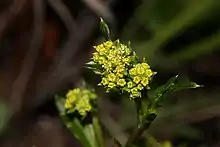Sanicula crassicaulis
Sanicula crassicaulis is a species of flowering plant in the parsley family known by the common names Pacific blacksnakeroot[1] and Pacific sanicle. It is native to the west coast of North America from British Columbia to Baja California, where it can be found in many types of habitat, including mountain slopes, grassland, and woodlands. It is a perennial herb producing a thick stem up to 1.2 meters tall from a taproot. The leaves have blades up to 12 centimeters long which are divided into a few deep lobes and edged with small teeth. The inflorescence is made up of one or more heads of bisexual and male-only flowers with tiny, curving, yellow petals. Each head has approximately five leaflike, lance-shaped bracts at its base. The rounded fruits are a few millimeters long, covered in curving prickles, and borne in small clusters.
| Sanicula crassicaulis | |
|---|---|
 | |
| var. tripartita | |
| Scientific classification | |
| Kingdom: | |
| (unranked): | |
| (unranked): | |
| (unranked): | |
| Order: | |
| Family: | |
| Genus: | |
| Species: | S. crassicaulis |
| Binomial name | |
| Sanicula crassicaulis | |
References
- "Sanicula crassicaulis". Natural Resources Conservation Service PLANTS Database. USDA. Retrieved 30 October 2015.
External links
- Calflora Database: Sanicula crassicaulis (Pacific blacksnakeroot, Pacific sanicle, Gamble weed)
- Jepson Manual Treatment
- USDA Plants Profile
- Washington Burke Museum
- U.C. Photos gallery
| Wikimedia Commons has media related to Sanicula crassicaulis. |